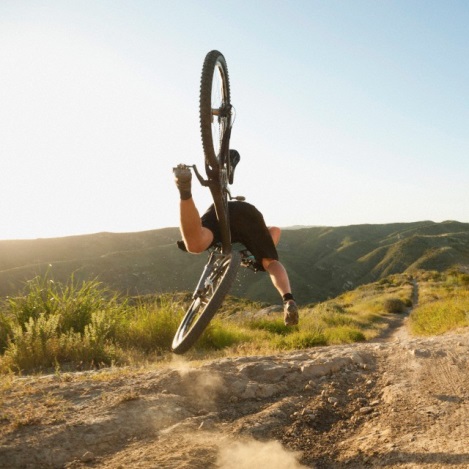How Safe is Your Bike Helmet Really?
by Michael Carlisle
When I was a kid nobody wore bike helmets. I don't know if they'd even been invented, but I never saw one. It's all different now – they're everywhere. In fact, they're compulsory. The first mandatory helmet law was passed in Victoria in 1990 and the other states and territories followed that example. Helmets are supported by a lot of public health campaigners, and so much has been said about them that most people now accept they're great for safety. There's no serious opposition to the laws and unless you have a religious exemption, or you're on private land, the chances are you've got to wear one. Of course if cycle helmets make you safer it would be pretty silly not to wear one anyway, but how safe are they really?
A modern helmet is basically a light plastic shell with a foam interior. They're designed to absorb impacts, usually by collapsing when they take a knock. It's a fact that most serious cycling injuries are from a blow to the head, either from a collision, going over the handlebars or just falling off. When you hit the ground at high speed there's a lot of energy involved, and if you can divert it into some place that isn't your skull your chances of walking away from the smash are a lot higher. That's the idea behind helmets.
Personally I'm not a hundred percent convinced. There's no doubt that all things being equal you're safer hitting something with a helmet on than without, but the thing about real life is all things usually aren't equal. There have been quite a few studies about helmets by now and the results aren't as clear as pro-helmet campaigners often make them out to be. The statistics look good for helmets at first glance but not so promising if you do a little digging. Here's an example: In the first two years after the helmet law was introduced in Victoria, head injuries to non-drivers fell by up to 7.5 percent. Some researchers claimed that showed the law was working.
What didn't get said was that the biggest decrease was among child pedestrians, who obviously weren't affected by the law anyway. For everyone else numbers stayed about the same as in the 1980s. That was a bit of a surprise, because a separate study found that the biggest change after the law was a big fall in the number of cyclists. Probably a lot of people, faced with the cost of buying a helmet, just never got round to it and left their bikes at the back of the garage. When you think about how healthy cycling is that makes you wonder if the helmet law harms more people than it helps.
Here's something else that studies found – cyclists wearing helmets tend to go faster, and that's probably because they think they're a lot safer than they really are. If you think you're protected the chances are you'll go faster, and generally take more risks. It's risky cycling that leads to head impacts, and a 1985 survey in South Australia found that 62 percent of cyclists who reported hitting their heads were wearing a helmet at the time. In 1985 only about 5% of cyclists wore helmets. Other studies in the USA found pretty much the same.
It looks like a helmet protects you if you have a serious accident, but the price is you're much more likely to have one in the first place. In Sydney the number of child cyclists fell by 44% in the two years after helmets became law but the decrease in head injuries was much smaller. What I found really interesting in this and other studies was that there was a big fall in cycling injuries, but it was in less serious ones that didn't involve head impacts.
Your chances of an accident aren't just down to you – how other road users act has a lot to do with it. The fact is that as a cyclist you're pretty vulnerable, especially to cars. Some drivers are rude and dangerous but to be fair most of them do look out for cyclists and give us plenty of space. The evidence is they'll give you less space if you're wearing a helmet, because they believe you're at less risk. On average they'll give you 6cm less space, which doesn't sound like a lot but can make all the difference between a miss and a collision.
There's no doubt that an approved cycling helmet – NEVER wear one that's not AS 2063 rated – will protect your head if you have a serious accident. That doesn't translate into real improved safety though, because all the research says they make you more likely to have that accident. Right now there's no getting round the law and helmets are part of cycling, but don't make the mistake of thinking they'll keep you safe – you're at just as much risk as you would be without one.

Follow Peter on Google+, Linkedin or visit his site at http://www.pushys.com.au/.
Join in and write your own page! It's easy to do. How? Simply click here to return to Sports.
Visit Our Stores:
Amazon
Ebay
Etsy
Better Display Cases
+1 The Best All Time Sports








